Fig. 1.
Models of Siglec-15–ligand interaction and downstream signaling. a Osteoclast differentiation. Siglec-15 on osteoclast precursor recognizes CD44 on adjacent osteoclast precursor and transduces the signal via DAP12–SYK pathway, which cross-talks with RANK–TRAF6 pathway and enhances downstream signaling (e.g., ERK and PI3K–AKT). Sialic acids (shown in purple diamonds) are required for this interaction. b Tumor microenvironment and microbial infection. In tumor microenvironment, Siglec-15 (on tumor-associated macrophages and/or cancer cells) engages an unknown receptor on T cells and dampens T cell responses required to suppress cancer growth. Likewise, Siglec-15 on myeloid and/or epithelial cells, induced by microbial pathogen, interacts with an unknown receptor on T cells and dampens T cell responses required to control infection. It is unknown whether the glycan recognition and/or signal transduction property of Siglec-15 is required in this model (Siglec-15 = ligand). Alternatively, Siglec-15 on myeloid cells may interact with cancer- or microbe-associated ligand and modulate the myeloid cell production of anti-inflammatory cytokine (e.g., TGF-β or IL-10), which suppresses T cell activation. This alternative model is similar to the one shown in (A) (Siglec-15 = receptor)

